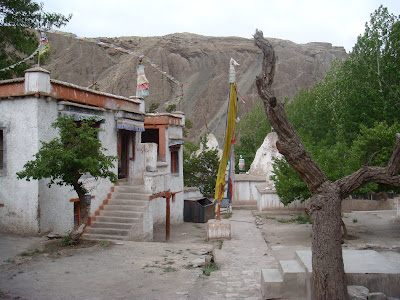We traversed the same route backwards in order to cover monasteries on the way. Our destination now was Alchi.



The temples of Alchi are in a class of their own. Sited on flat ground and not the usual hillside, the 12th century shrines, abandoned probably in the 15th century boast of the most magnificent murals in all Ladakh, they hark back to a time when Tibetan Buddhism, still looking to India for inspiration, was making its first inroads into the region.
Alchi’s sculptures and murals betray little influence of China and Tibet. What they preserve is the artistic style and tradition of Buddhist northern India, particularly Kashmir that disappeared almost without trace from the subcontinent in the years after the Muslim conquest and depredations of the 12th century.
A narrow path, lined with souvenir stalls leads to the choskar, the religious enclave. The first sight of the Alchi temples leaves most visitors unimpressed; from the outside, they seem to be modest, unremarkable mud houses, not indicating the artistic wealth within.
The stylisation will strike you as markedly different from that you have seen in other Ladakh gompas. The facial features are more mainstream Indian than Mongoloid.
Alchi’s most impressive temple is the Sumtsek. Thr name means three tiered. The temple rises to three floors, with a high entrance porch that is supported by carved wooden columns and beams. The ornamentation of the wooden support framework employs Greco-Gandhara architectural motifs used in Kashmir in the period between 7th and 10th century AD.
The three pediment like triangular gables between the beams each encasing a trefoliated(three lobed) arch that encloses a Buddha image. It is a format common in the pre-Islamic architecture of Kashmir. These design elements came to Kashmir from Gandhara, influenced and ruled or a period by the post Alexandrian Bactrian Greeks.
As you enter the dark inside, you will notice 3 colossal statues - of avalokiteshwara, maitreya and Manjushree - on the 3 sides of the square chamber with a large stupa in the middle.
Photography is prohibited inside all the temples.
There is a courtyard through which one passes to reach other temples, all of which prohibit photography.
All temples are treasure houses of very old and significant murals, elaborate and detailed sculptures and clay figures.
As we returned, I tried to capture as much beauty surrounding the place as I could.


































No comments:
Post a Comment